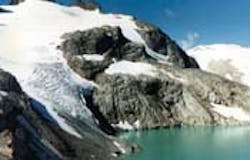Cascades Glacier May Vanish By End Of Century
The South Cascade Glacier has been shrinking at such a rapid pace over the past three decades that scientists predict it could melt away completely within a century, The Associated Press reported.
Since 1959, scientists have been studying the South Cascade South Cascade. It is one of only a few ice fields in the world being studied for long-term effects of climate changes, to better understand connections between glaciers and global warming, weather and water supply, nature and humans.
The glacier, in the Glacier Peak Wilderness of the North Cascades, is at the head of the Cascade River, which drains into the Skagit River and Puget Sound.
Glaciers make up three-quarters of the "permanent" ice in the lower 48 states and drain into rivers to provide water for people, fish, industry and recreation.
Nearly all of the state's 700 glaciers are receding rapidly, and others have disappeared in the past few decades, according to The Associated Press.
Since 1983, students from Nichols College in Dudley, Mass., have been studying glaciers in the North Cascades, nearly all of which drain into the Columbia River system. Near Mount Stuart, the college recorded 15 glaciers in 1969.
Now there are 12, four of them dwindling rapidly.
Deprived of sufficient snowfall and melted by warming temperatures, the receding glaciers could one day mean less fresh water for river systems.
"The whole way we manage water may one day have to change," said Mark Savoca, chief of physical hydrology for the U.S. Geological Survey's Washington Water Science Center in Tacoma, which monitors the South Cascade Glacier.
"Instead of ice and snow being a natural storage system for the gradual release of water during the middle to late summer, we may have to manage storage using a different system altogether."
According to Bill Bidlake, a U.S. Geological Survey hydrologist studying the South Cascade Glacier, seasonal snowmelt and groundwater runoff contribute in the spring and early summer. However, the systems are fed almost entirely by glaciers in the late summer and fall.
In Eastern Washington, the glaciers provide critical water during the dry months.
Bidlake explained that if the glaciers continue to decrease in size and if some disappear altogether, it will have a significant impact on the mountain ecosystems.
According to studies, the glacier has been alternately advancing and shrinking since the last Ice Age. Since its last major advance in the late 1500s, the glacier has retreated more than three-quarters of a mile. About a third of that retreat has occurred since 1959.
Scientists are concerned that the rate of decrease in the glacial size and mass seems to have gotten a lot more rapid in the last 25 to 30 years. They visit the remote site in the Glacier Peak Wilderness about six times a year, measuring winter snowfall and summer melt, ice thickness and water quantity, and collecting weather readings.
Research suggests the glacier made a significant advance starting around 3000 B.C. Then, in the late 16th century, it began to retreat.
A smaller advance ended in the late 19th century, and it has been retreating ever since. Similar retreats are being noted at ice fields around the world.
Some experts believe industry and the burning of fossil fuels are contributing to the problem. In the past century, some glaciers and ice shelves have melted completely.
According to the report, scientists really don't know how much, if any, of the melting is caused by humans and how much by natural climate fluctuations.
Source: The Associated Press
